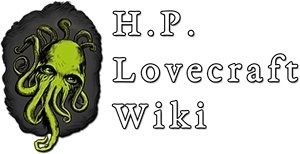No edit summary |
No edit summary |
||
| Line 7: | Line 7: | ||
}}The 42 clay fragments found by the Rev. Brooke Winters-Hall in 1912 in Eltdown, Sussex, England, are referred to as “The Sussex Fragments” to distinguish them from the fragmentary writings found near Eltdown, U.S.A., by Doctors Dalton and Woodford in 1891, with which they share much, and which they may be an alternative version of (See The [[Eltdown Shards]]). |
}}The 42 clay fragments found by the Rev. Brooke Winters-Hall in 1912 in Eltdown, Sussex, England, are referred to as “The Sussex Fragments” to distinguish them from the fragmentary writings found near Eltdown, U.S.A., by Doctors Dalton and Woodford in 1891, with which they share much, and which they may be an alternative version of (See The [[Eltdown Shards]]). |
||
| − | Outside the Mythos |
+ | ==Outside the Mythos== |
| + | |||
| + | |||
The name is used by August Derleth (some say after Lovecraft, some say as advertisement for Fred Pelton's [[Sussex Manuscript]]); Laurence J. Cornford signed the term to the version of The Eltdown Shards outlined in "The Challenge From Beyond". |
The name is used by August Derleth (some say after Lovecraft, some say as advertisement for Fred Pelton's [[Sussex Manuscript]]); Laurence J. Cornford signed the term to the version of The Eltdown Shards outlined in "The Challenge From Beyond". |
||
Revision as of 15:50, 26 June 2018
The 42 clay fragments found by the Rev. Brooke Winters-Hall in 1912 in Eltdown, Sussex, England, are referred to as “The Sussex Fragments” to distinguish them from the fragmentary writings found near Eltdown, U.S.A., by Doctors Dalton and Woodford in 1891, with which they share much, and which they may be an alternative version of (See The Eltdown Shards).
Outside the Mythos
The name is used by August Derleth (some say after Lovecraft, some say as advertisement for Fred Pelton's Sussex Manuscript); Laurence J. Cornford signed the term to the version of The Eltdown Shards outlined in "The Challenge From Beyond".
